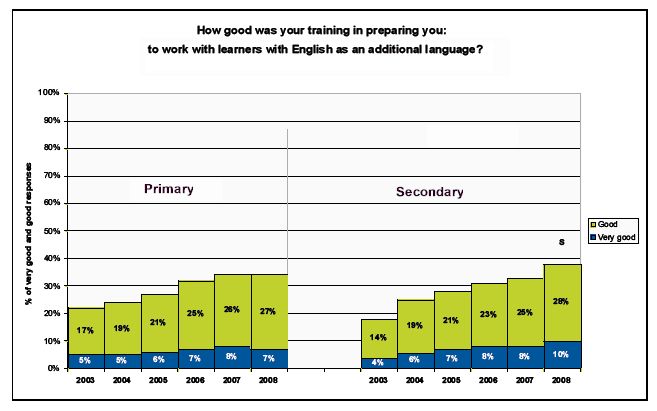

In 2004, the TDA supported NALDIC, along with other subject associations, to create subject resource networks (SRN). These subject resource networks provided subject-specific initial teacher training (ITT) materials. They introduced new and existing ITT trainers to current thinking, research and professional networks in particular subject areas. NALDIC created the SRN for EAL.
Although focussed on ITT needs, these web-based networks contained useful materials for developing EAL subject knowledge for the whole school workforce. The aims of the EAL SRN was to:
- Induct and support new ITT trainers
- Further develop a bank of resources to enhance subject and curriculum knowledge and pedagogy
- Respond to policies and central strategies
- Provide access to research and evidence that informs teacher education
The project was extremely successful. For example, the annual NQT survey showed that percentage of secondary newly qualified teachers rating their preparation to teach EAL learners as good or very good doubled between 2003 and 2008.

In 2008, the TDA funded NALDIC to undertake a national audit of CPD training to inform the 5 year National EAL Strategy. This audit included information about over 200 in-service courses involving over 11,000 staff and found an inconsistent picture. The content of much training was induction or entry level which might reasonably be expected to form part of every teachers’ initial teacher education. There was very limited provision for EAL early professional development and some evidence that the absence of nationally agreed content areas had led to CPD and vocational provision that is reactive rather than progressive, and to development issues being displaced by short term foci.
Only 12% of the training was accredited, and only a quarter was sustained over a term of longer. The major gap identified by survey respondents was sustained and accredited CPD for EAL specialists and coordinators. In addition, there were difficulties in potential participants accessing useful information about CPD and training opportunities.
NALDIC supported the 5 year National EAL strategy as a member of the steering group, providing expert advice on the work led by the the Institute of Education to promote and enhance initial and continuing teacher education about EAL.
In 2011, NALDIC supported the TDA's 'Leading Partners in EAL' project. Building on our previous work in this area and the initial piloting of professional development modules in Leeds in July 2011, we hosted a series of 3 professional network events. These took place across the regions in January and March 2012 to provide professional development modules for EAL for course developers and programme managers from HE institutions, training schools, SCITTs, EBITTs and other training providers.